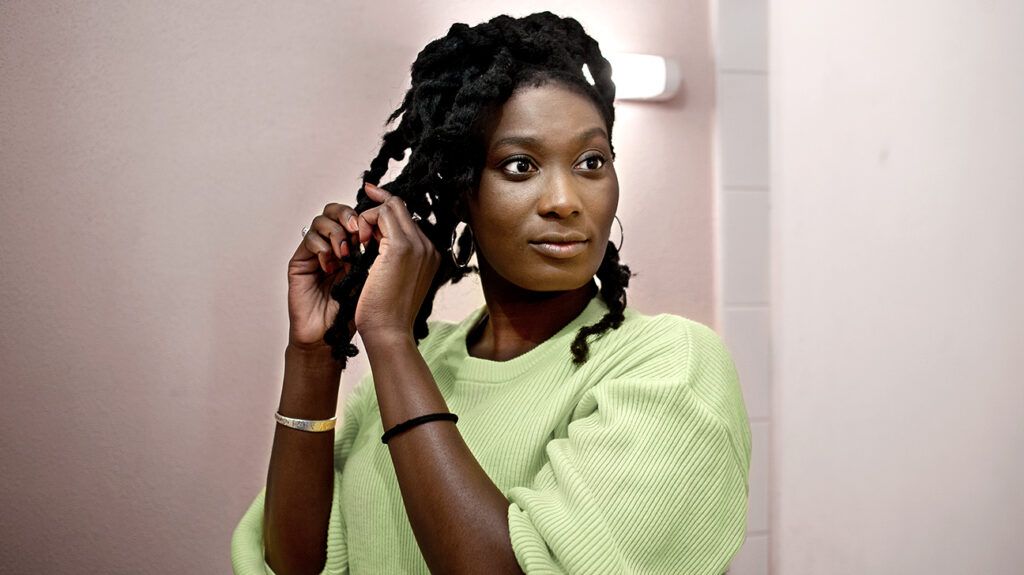Hair can be an important aspect of identity and self-expression for Black women. Specific treatments for scalp eczema may reduce symptoms without damaging different textures and styles of Black hair.
Eczema is an inflammatory skin condition that causes itchy, scaly skin. When it occurs on the scalp, it can resemble dandruff.
Some groups are at greater risk of eczema than others, and scalp eczema is especially prevalent in Black women.
This may be due to various reasons, including specific hair practices and many doctors’ lack of appropriate understanding and treatment methods.
This article looks at scalp eczema in Black women and treatments for scalp eczema on Black skin.

Seborrheic dermatitis (SD) is a type of eczema that often affects the scalp and face. It may cause dry, flaky skin, a rash, itching, and burning.
SD occurs in areas that produce a lot of oil called sebum. An overgrowth of Malassezia yeast
Research indicates that SD is among the 5 most common dermatological diagnoses in Black people and is especially prevalent in Black women.
Hairstyles are an important expression of culture and identity to many Black women and have historically even played a role in the American Civil Rights Movement.
There is a
Treatments for SD in Black women must consider and factor in the personal and cultural significance of hair.
Doctors may have to modify SD treatments for Black women according to different hair textures and styles.
Products and medications that may successfully treat SD in white people may not be appropriate for Black hair and may cause damage and hair breakage.
To help treat scalp eczema on Black skin with minimal hair damage, a person can consider implementing the following tips:
- shampooing once a week or once every 2 weeks for tightly coiled hair types
- using hair oil or pomade on the hair shaft rather than on the scalp
- using medicated oil or ointment preparations instead of foams or gels
- loosening locs or braids to help avoid sebum buildup
- using specialized shampoos and conditioners that contain preparations such as coal tar, zinc pyrithione, and 1–2% ketoconazole
- applying specialized shampoos directly to the scalp rather than the hair shaft to avoid hair damage and breakage
- taking a course of prescription corticosteroids if a healthcare professional recommends doing so
Learn moreLearn more about eczema on Black skin and skin of color.
Application, products, and washing techniques may differ depending on a person’s hairstyle and texture.
If a person has chemically treated or dyed hair, they may need to use gentler products to avoid hair damage, maintain color, and minimize scalp irritation.
Applying these products to the scalp rather than the hair shaft may help limit hair damage.
Additionally, if a hairstyle consists of braids or locs, it is best to loosen them to apply treatment. Loosening them can also help avoid the sebum buildup that can cause SD.
Shampoo and conditioning products that include the following may help with SD:
- zinc pyrithione
- 1–2% ketoconazole
- coal tar
Prescription antifungal shampoos may also help SD. They include:
- ciclopirox 1% (Loprox)
- ketoconazole 2% (Nizoral)
Steroid shampoos, such as clobetasol 0.05% shampoo (Clobex), can also help. A person can alternate using this week-by-week with ketoconazole 2% antifungal shampoo.
How to use
It is best to follow the directions on the leaflets for the specific product.
However, in general, a person can follow these steps:
- Work the product into the hair, starting at the scalp.
- For natural or chemically treated hair, lightly comb through the hair, starting at the scalp, and gradually working down to detangle.
- Loosen and section any braids and locs before massaging the product into the hair and scalp.
- Leave the product in the hair for the time specified by the manufacturer or a medical professional.
- Rinse.
Products to avoid
Some products can increase irritation and scalp dryness, and it is best for a person with SD to avoid them.
These include over-the-counter (OTC) products to treat scalp eczema and dandruff, as they may cause severe dryness and hair breakage in Black hair.
Shampoos with added fragrance can also increase irritation.
Research indicates some hair care practices to maintain certain hairstyles and textures among Black women may worsen scalp eczema.
These include:
- regular use of hair oils and pomade
- infrequent shampooing
- use of chemical relaxers
- use of hair extensions
Black hair and scalp may respond best to oil preparations or ointment. Gentle, oil-based sprays and moisturizers can help soothe the scalp — options include E45 cream and coconut oil.
A person can leave these in the hair with a towel or shower cap. However, it is best to do a patch test first to check that the product is compatible with an individual’s skin.
A patch test involves applying the product to a small area of skin behind the ear and leaving it for 24 hours. If there is a skin reaction, it is best to discontinue use.
People may need to use some scalp care products before shampooing and conditioning.
It is best to rub underneath any braids or locs to reach the scalp and let the product sit for a few minutes or overnight, depending on the product guidelines.
Black women may be at higher risk of developing scalp eczema than the larger population. Research indicates that this may be partly due to hair practices for the maintenance of certain hairstyles, such as the regular use of pomade, chemical straightening, and hair extensions.
Treatments that are effective for white hair may cause damage and breakage in Black hair. To minimize hair damage, Black women can apply medicated products to the scalp, rather than the hair shaft.
Using pomade on the hair shaft and avoiding application to the scalp may help reduce scalp eczema. Loosening hairstyles like braids or locs can also help reduce the buildup of sebum on the scalp.
